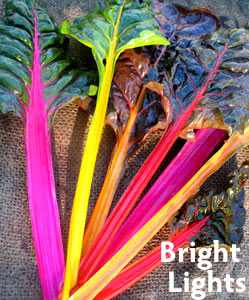GROW CHARD: It's Easy and Nutritious
Vincent Lazaneo
 Chard, also known as Swiss chard, is one of the easiest vegetables to grow. It requires the same care as beets, a close relative, although chard is grown for its flavorful leaves and succulent stalks. All you need is a sunny location and average garden soil or a large container. The plants bear heavily and produce greens most of the year. Their leaves can be cooked or used fresh in salads. They are very nutritious and provide both vitamins (A and C) and minerals (potassium, iron, calcium and magnesium).
Chard, also known as Swiss chard, is one of the easiest vegetables to grow. It requires the same care as beets, a close relative, although chard is grown for its flavorful leaves and succulent stalks. All you need is a sunny location and average garden soil or a large container. The plants bear heavily and produce greens most of the year. Their leaves can be cooked or used fresh in salads. They are very nutritious and provide both vitamins (A and C) and minerals (potassium, iron, calcium and magnesium).
Chard is usually planted in early spring (February-May) but it can also be planted during fall in areas where winters are mild. It is easy to grow from seed, or you can buy small plants for a faster start.
Prepare your soil for planting by digging to a depth of 8-12 inches. Mix in some starter fertilizer like 5-10-5, and a generous amount of compost. Level the surface of the soil with a rake. Plant the big, crinkly, tan seeds ½-inch deep and space them three inches apart in a row. When the young plants have grown six inches tall, thin them to one foot apart. This final spacing should also be used if you start with transplants.
After planting, water gently and wet the soil to a depth of at least six inches. Keep the soil moist, but not too wet with periodic light sprinkling until seedlings appear. Water thoroughly and less often as plants grow larger. Fertilize lightly about two months after planting and again 2 – 3 months later.
Chard should be ready to harvest in 60-90 days, depending on the weather. Harvest from the plant by breaking away or cutting off a few fully grown leaves near the base. New leaves continue to grow from the center as the older ones are cut away.
You can harvest many times from one plant. If you do not harvest the outer leaves, they become stringy and tough. If a plant “bolts” and starts to produce a seed stalk, harvest all good leaves, then pull out the plant and put it in your compost pile. 
Standard varieties of chard have dark green foliage and white stalks. A colorful variety, ‘Bright Lights’, has leaves ranging from green to burgundy, and stalks in various shades of yellow, orange, red, pink and purple. The variety called ‘Rhubarb’ has reddish-green leaves and bright red stems.
Vincent Lazaneo Urban Horticulture Advisor Emeritus for UC Cooperative Extension. He helped found the San Diego County Master Gardener Association more than two decades ago and served as its advisor. He is the author of numerous articles on plants and pests that appeared in the San Diego Union-Tribune, California Garden and other publications.

